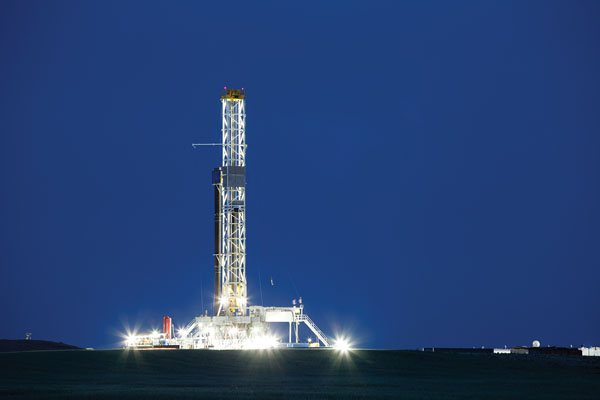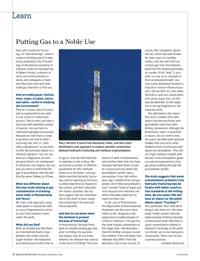Learn
 WELL WATER? A team from Rochester, Duke, and Ohio State developed a new approach to explore possible connections between hydraulic
fracturing and methane in groundwater. (Photo: iStockphoto)
WELL WATER? A team from Rochester, Duke, and Ohio State developed a new approach to explore possible connections between hydraulic
fracturing and methane in groundwater. (Photo: iStockphoto)How safe is hydraulic fracturing—or “hydrofracking”—when it comes to drinking water? A new study, published in the Proceedings of the National Academy of Sciences, draws on the expertise of Robert Poreda, professor of earth and environmental sciences, and colleagues at Duke and Ohio State who work with noble gas chemistry to find out.
How are noble gases—helium, neon, argon, krypton, xenon, and radon—useful in studying the environment?
They’re a unique class of tracers, and as a geoscientist you need to use tracers to understand process. They’re inert and have a fixed and well-identified number of sources. You use them to understand geological processes because you don’t have a scope to go down and look at what’s occurring 100, 500, or 1,000 miles underground—so you have to infer the processes based on a chemical signature. You can use them as a fingerprint, for temperature history, for involvement of volcanism and magma. You can also use them to determine the age of groundwater and the path that the water follows as it flows.
What was different about this new study looking at gas contamination in drinking-water wells in Pennsylvania and Texas?
We took a new approach, using noble gases in conjunction with an array of geochemical tracers to trace how methane moves under the earth.
What did you find?
What we showed was that there are intermediate levels of gas between the surface and the target horizon—the horizontal area below ground where the oil or gas is—that the well itself aids in migration to the surface. We envisioned a number of different possibilities for why methane shows up in the water—one possibility was that hydraulic fracturing could be opening up fractures to allow deep brine to migrate to the surface, and that’s what gets the media’s attention. But our data suggest that the contamination is the result of poor casing and cementing in the hydraulic fracturing wells.
And how do you know when the methane is present because of fracturing?
In Pennsylvania, because there were no reliable existing gas data prior to drilling, the question was always, how do you know whether the methane was natural or the result of drilling? There are dozens of wells in Pennsylvania and southern New York that have elevated methane levels caused by a natural process where the groundwater aquifer taps a pre-existing—from 300 million years ago—shallow brine and gas pocket. All of these groundwaters have “normal” levels of argon and neon because only methane and helium has been added but no argon has been lost.
In the case of Pennsylvania, the Department of Environmental Protection and the courts have relied on the “pregnancy test” application of stable isotopes of carbon in methane. If the gas has the same isotopic composition as the target zone—the Marcellus—then the drilling company caused the problem. If the well water had methane that differs from the Marcellus, then it was natural. Of course, they completely ignore the fact, which has been known for many years in Canadian studies, that the well itself can conduct gas from intermediate levels into the shallow groundwater aquifer. If this “leak” is very slow—as may occur naturally or from an abandoned well—you can’t easily distinguish between a natural or human-influenced process. And we don’t try. Only when the leak is rapid and catastrophic, and causes argon loss, can the leak be identified. So the argon loss is the big fingerprint in the impacted wells.
The well owners also report that all of a sudden their well waters had become frothy with gas bubbles some time after drilling commenced. Although the homeowner report is anecdotal in nature, we can confirm that the water was filled with methane bubbles that only occur when methane exists at pressures well above one atmosphere. Thus, the very high methane coupled with the loss of the atmospheric gases can only be explained by a free gas phase bubbling through the groundwater aquifer.
The study suggests that water contamination problems from hydraulic fracturing may be fixable with better construction standards at the drilling sites. Do you expect this will have an impact on the public debate about “fracking”?
Yes, absolutely. That’s why we’re doing it. But there isn’t the same public health concern directed toward people drinking naturally contaminated water that there is about contamination related to hydraulic fracturing. In this political climate, you’re not seeing any compromise. There can’t be any nuanced positions. —
Kathleen McGarvey

